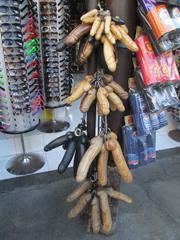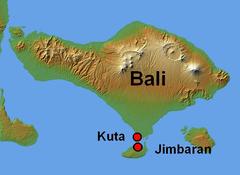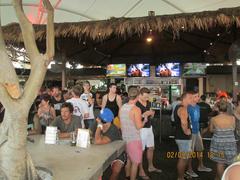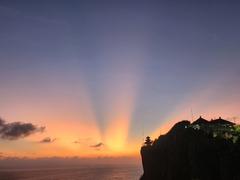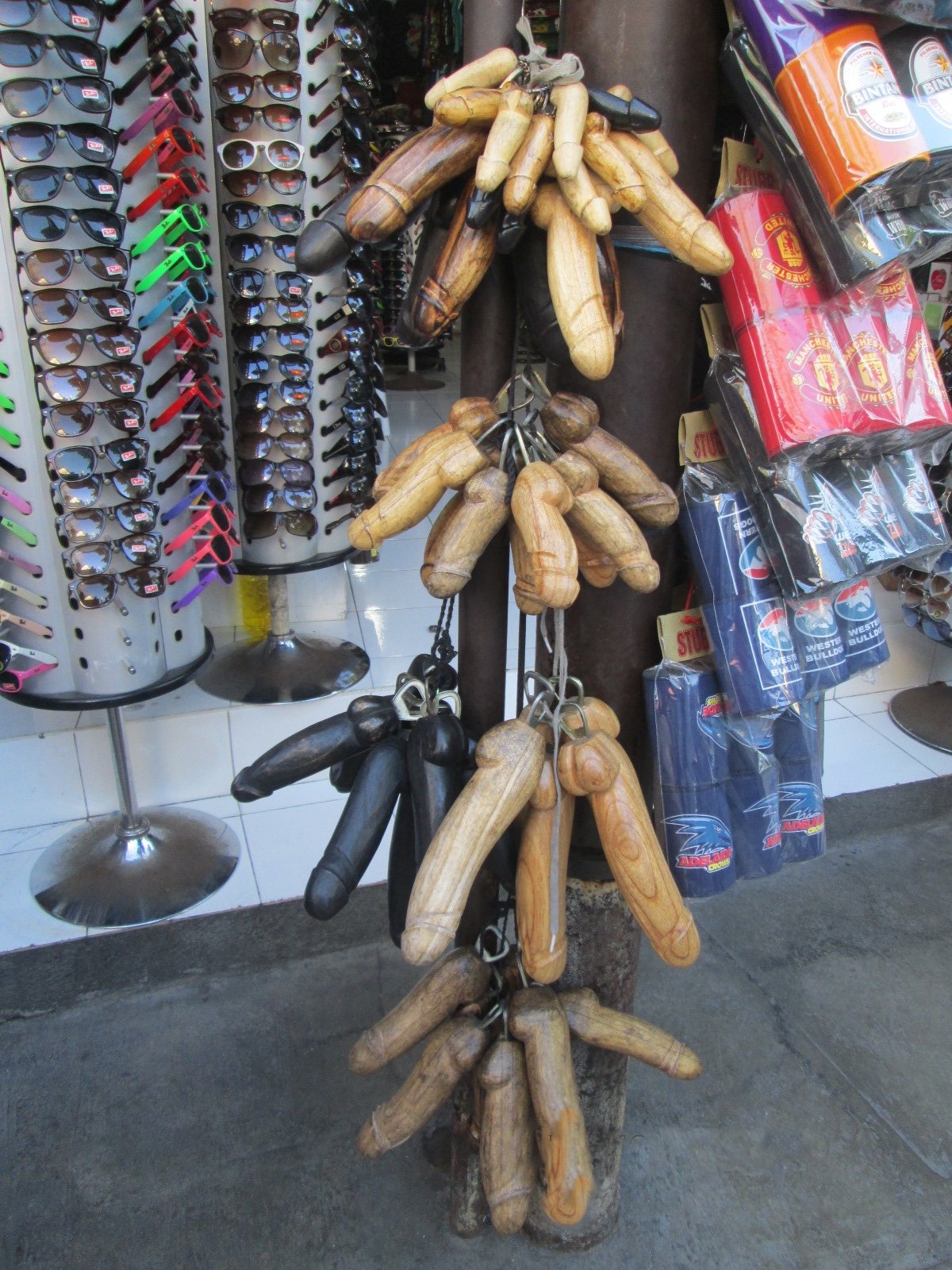
Kuta Badung Indonesia: Visiting Hours, Tickets, and Historical Sites Guide
Date: 14/06/2025
Introduction to Kuta Badung and Its Historical Significance
Kuta, situated within the Badung Regency of southern Bali, Indonesia, is one of the island’s most iconic beach destinations. Once a quiet fishing and agricultural village, predominantly inhabited by Balinese Hindus, Kuta has transformed into a vibrant international resort renowned for its breathtaking white sandy beaches, energetic nightlife, and enduring cultural heritage. The name “Kuta,” meaning “fortress” or “city,” alludes to its historical role as a place of both protection and gathering, originally surrounded by forested areas known as “Alas Kuta” (Wikipedia: Kuta, Bali).
In the 19th century, Danish trader Mads Johansen Lange played a pivotal role in Kuta’s development, facilitating trade and cultural exchange. His influence endures, notably through his gravesite, which remains a local historical landmark. The area’s early interaction with international traders and travelers established the foundation for Kuta’s cosmopolitan spirit. By the early 20th century, Kuta had become a magnet for artists, surfers, and backpackers, especially from Australia, drawn by its surf-friendly beaches and relaxed atmosphere (CyberLeninka).
Beyond its coast, Kuta is deeply rooted in Balinese Hinduism, vibrant artistic traditions, and community rituals. Visitors can experience cultural activities such as temple ceremonies, traditional dance performances, and major festivals like Nyepi and the Ogoh-Ogoh parade. Kuta also offers a diverse array of attractions, from family-friendly water parks like Waterbom Bali to bustling markets selling authentic Balinese crafts (Bali Touristic; The Crazy Tourist).
Practicalities are well-managed in Kuta. Its proximity to Ngurah Rai International Airport makes it easily accessible, and accommodations range from budget hostels to luxury resorts. Transport options include taxis, ride-hailing services, and scooter rentals. Visitors are encouraged to respect local customs, dress modestly at temples, and stay aware of safety recommendations, such as watching for strong beach currents and securing personal belongings (bali.com; TripCanvas).
Whether you’re drawn by Kuta’s vibrant surf culture, deep-rooted traditions, lively nightlife, or family attractions, this guide will help you plan a rewarding visit, offering insights into its history, culture, top sights, visiting hours, ticketing, travel tips, and more.
Contents
- Discover Kuta, Bali: History, Attractions, Tickets & Travel Tips
- History and Origins
- Top Attractions and Landmarks
- Visiting Hours and Ticket Information
- Travel Tips
- Accessibility
- Nearby Attractions
- Special Events and Guided Tours
- FAQ
- Resilience and Modern Appeal
- Discovering the Cultural Significance of Kuta, Badung: Visitor’s Guide
- Historical Evolution
- Balinese Hinduism and Rituals
- Community Structure
- Artistic Traditions
- Festivals and Ceremonial Life
- Visitor Information
- Responsible Tourism
- Culinary Traditions
- Cultural Preservation
- FAQ
- Top Attractions and Activities in Kuta: Visiting Hours, Tickets, and Tips
- Kuta Beach
- Waterbom Bali
- Bali Sea Turtle Society
- Shopping and Markets
- Cultural Sites and Heritage Walks
- Nightlife
- Unique Experiences
- Adventure Sports
- Sunset Cruises and Beach Clubs
- Family-Friendly Activities
- Practical Tips
- FAQ
- Kuta Badung Visitor Guide: Entry, Accommodation, and Practical Information
- Entry Requirements and Visas
- Transportation
- Accommodation
- Attractions and Photo Spots
- Safety and Security
- Health and Beach Safety
- Connectivity
- Money and Budgeting
- Shopping
- Nightlife
- Cultural Etiquette
- Events and Festivals
- FAQ
- Practical Tips
Discover Kuta, Bali: A Vibrant Beach Destination with Rich History
History and Origins
Kuta’s name derives from the word for “fortress” or “city,” referencing its strategic and cultural importance. Once called “Kuta Mimba” or “Alas Kuta,” the area was characterized by dense forests and traditional villages. The influence of foreign traders, particularly in the 19th century, marked the beginning of Kuta’s transformation from a quiet village into a global destination, especially after the arrival of figures like Mads Lange (CyberLeninka; Wikipedia: Kuta, Bali).
Top Attractions and Landmarks
- Kuta Beach: Known for its long stretch of fine white sand, gentle surf, and spectacular sunsets.
- Kuta Art Market: A bustling hub for Balinese handicrafts and souvenirs.
- Mads Lange’s Grave: A key historical site commemorating Kuta’s early international connections.
- Traditional Temples: Including Pura Petitenget and Pura Segara, providing insight into Balinese Hindu rituals.
Visiting Hours and Ticket Information
- Kuta Beach: Open 24 hours; surf schools and rentals typically from 7:00 AM to 6:00 PM.
- Temples and Cultural Sites: Generally open 8:00 AM to 6:00 PM. Modest entrance fees may apply at certain temples and for cultural performances.
Travel Tips
- Best Time to Visit: April–October (dry season) ensures sunny weather and great surfing.
- Getting There: 10–15 minutes by car from Ngurah Rai International Airport.
- Local Customs: Wear modest clothing at temples and be respectful of ceremonies.
- Currency: Indonesian Rupiah (IDR); ATMs and money changers are widely available.
Accessibility
Kuta offers accommodations for every budget, with many properties and attractions providing facilities for travelers with mobility needs. Public transport is available, along with taxis, ride-hailing, and scooter rentals.
Nearby Attractions
- Legian & Seminyak: Northern neighbors renowned for upscale dining and shopping.
- Waterbom Bali: Premier water park for families.
- Tanah Lot Temple: Famous offshore temple, about an hour’s drive from Kuta.
Special Events and Guided Tours
Kuta’s calendar features festivals such as the Bali Arts Festival and the Ogoh-Ogoh parade. Guided tours for surfing, cultural immersion, and culinary exploration are widely offered.
Frequently Asked Questions (FAQ)
-
Q: What are Kuta’s visiting hours?
- Beaches and markets: open daily, early morning to late evening. Temples: 8:00 AM to 6:00 PM.
-
Q: Is there a ticket required for Kuta Beach?
- No ticket is necessary for the beach.
-
Q: Is Kuta family-friendly?
- Yes, with attractions like Waterbom Bali and the Bali Sea Turtle Society.
-
Q: When is the best time to visit Kuta?
- April–October (dry season).
Resilience and Modern Appeal
Kuta has demonstrated remarkable resilience, recovering from challenges such as the 2002 Bali bombings and the COVID-19 pandemic. The local government is committed to sustainable tourism and cultural preservation (The Bali Lifestyle).
Discovering the Cultural Significance of Kuta, Badung
Historical Evolution
Kuta’s cultural evolution is marked by its transformation from a fishing village to a cosmopolitan hub. Early international trade, especially with European merchants, shaped its open, diverse character (Salut Bali; Bali Ventur).
Balinese Hinduism and Rituals
Balinese Hinduism is central to Kuta’s identity. Daily offerings, temple festivals (e.g., Galungan, Kuningan, Nyepi), and community-based rituals structure local life (Bali by Locals; Bali Touristic).
Community Structure
The traditional desa adat (village council) and banjar (neighborhood council) promote social harmony through the organization of festivals and community support (Overyourplace).
Artistic Traditions
Kuta is home to vibrant performing arts such as Kecak, Legong, and Barong dances, often performed at local temples and cultural venues. Local crafts, including woodcarving and weaving, are showcased in markets and galleries (Bali by Locals; Bali Touristic).
Festivals and Ceremonial Life
Key events include Nyepi (Day of Silence) and the Ogoh-Ogoh parade, with giant effigies paraded through the streets. During Galungan and Kuningan, temples are decorated, and families come together for prayers and celebrations (Overyourplace; Bali Touristic).
Visitor Information
- Opening Hours: Temples and museums: 8:00 AM–6:00 PM; performances: evenings.
- Tickets: Many temples are free or donation-based; cultural shows cost IDR 100,000–200,000. Book ahead during peak seasons.
- Accessibility: Some sites are wheelchair-accessible; others have steps or uneven terrain.
- Dress Code: Modest attire; sarongs/sashes for temple visits.
Responsible Tourism
Visitors should respect local traditions, dress appropriately, and ask permission before photographing ceremonies or individuals (Bali Touristic).
Culinary Traditions
Kuta’s culinary offerings include Balinese staples such as babi guling, lawar, and sate lilit, served in local warungs and at markets. Participating in cooking classes or communal feasts provides authentic cultural insights (TripCanvas).
Cultural Preservation
Efforts by local authorities and community leaders focus on maintaining traditional arts, rituals, and values alongside modern tourism (Bali by Locals).
FAQ
- Q: When do major festivals occur?
- Nyepi (March, varies), Galungan, and Kuningan (date varies).
- Q: Are entrance fees required at temples?
- Mostly free or donation-based; ticketed shows require purchase.
- Q: Can tourists observe ceremonies?
- Yes, with respect for local customs and dress codes.
- Q: Where to buy local crafts?
- Kuta Art Market, artisan workshops, and galleries.
Top Attractions and Activities in Kuta
Kuta Beach
A hotspot for surfing, sunbathing, and socializing, Kuta Beach is accessible 24 hours a day. Surf lessons and board rentals are available from 7:00 AM to 6:00 PM (The Backpacking Family; TravelTriangle).
Waterbom Bali
Renowned for its diverse water slides and lush setting, Waterbom Bali is open 9:00 AM–6:00 PM. Tickets: IDR 520,000 (adult), IDR 410,000 (child) (The Crazy Tourist).
Bali Sea Turtle Society
Engage in turtle conservation efforts, including seasonal baby turtle releases. Open 8:00 AM–5:00 PM; check for event schedules (Indonesia Impression Tour).
Shopping and Markets
Beachwalk Shopping Center and Kuta Art Market offer a spectrum of shopping options. Markets generally operate 10:00 AM–10:00 PM (The Crazy Tourist).
Cultural Sites and Heritage Walks
- Pura Petitenget: 7:00 AM–6:00 PM (Secret Attractions).
- Pura Segara: Open daylight hours.
- Kuta Heritage Walk: Guided tours cover historic and cultural highlights.
- Bali Bombing Memorial: Open to the public for reflection.
Nightlife
Legian Street and surrounding areas buzz with bars, clubs, and live music from 6:00 PM until late (Indonesia Impression Tour).
Unique Experiences
- Ogoh-Ogoh Parade: Annual event before Nyepi (Indonesia Impression Tour).
- Kuta Theater: Nightly performances, 7:00–8:30 PM (TravelTriangle).
- Art Workshops: Available at select hotels and galleries (Secret Attractions).
- Catur Muka Statue: Popular photo spot.
Water Sports and Adventure
Surfing, parasailing, jet skiing, and snorkeling are widely available. Adventure tours to Ubud and surrounding areas can be arranged (Klook).
Sunset Cruises and Beach Clubs
Enjoy ocean cruises or relax at beach clubs like Atlas Beach Club for cocktails and panoramic views (Indonesia Impression Tour).
Family-Friendly Activities
Waterbom Bali, the Bali Sea Turtle Society, and Kuta Theater offer experiences for all ages (The Crazy Tourist).
Practical Tips
- Language: Indonesian (Bahasa Indonesia); English widely spoken.
- Transportation: Taxis, ride-hailing apps, and hotel shuttles are readily available (Indonesia Impression Tour).
- Dress Code: Modest attire at temples and ceremonies.
- Safety: Stay alert in crowds and at night; use waterproof pouches at the beach.
FAQ
- Q: What are Waterbom Bali’s hours?
- 9:00 AM–6:00 PM.
- Q: Are tickets needed for temples?
- Some require small fees; check locally.
- Q: Is Kuta accessible to travelers with disabilities?
- Many attractions are equipped with facilities.
- Q: Best time for surfing?
- April–October (dry season).
- Q: How to get around?
- Taxis, Grab, Gojek, hotel transfers.
Kuta Badung Visitor Guide: Entry, Accommodation, and Travel Tips
Entry Requirements and Visas
Most travelers can obtain a 30-day Visa on Arrival, extendable once. Longer stays require a Visit Visa (211A). Ensure your passport has six months’ validity (bali.com; InvestinAsia).
Transportation
Close to Ngurah Rai International Airport, Kuta is easily reached by taxi or shuttle. Public buses, hotel shuttles, private cars, and scooters are available (bali.com; TripCanvas).
Accommodation
From budget hostels to five-star resorts, Kuta offers a wide range. Peak seasons require advance bookings (KKday).
Attractions and Photo Spots
Notable locations include Waterbom Bali, Kuta Beachwalk, and Tanah Lot. Guided tours provide deeper cultural immersion.
Safety and Security
Petty theft can occur; keep valuables secure (The Broke Backpacker). Watch for open manholes and be cautious at night (Bali Seminyak).
Health and Beach Safety
Apply sunscreen, drink bottled water, and heed beach safety warnings regarding currents and riptides.
Connectivity
WiFi is widely available, but purchasing a local 4G SIM card ensures reliable connectivity (KKday).
Money and Budgeting
Bargain in markets; use ATMs attached to banks. Street food is affordable, and cash is widely used (bali.com).
Shopping
Beachwalk Shopping Center and Kuta Art Market are popular destinations for shopping and souvenirs.
Nightlife
Kuta’s nightlife is energetic; exercise caution and avoid counterfeit alcohol (The Broke Backpacker).
Cultural Etiquette
Dress modestly at temples, respect ceremonies, and dispose of trash properly (Bali Seminyak).
Events and Festivals
Plan around events like Nyepi, when the island observes a day of silence. Check the Bali Events Calendar for updates.
FAQ
- Q: Major attraction hours?
- Most open 8:00 AM–6:00 PM; nightlife venues operate until late.
- Q: Entrance tickets?
- Kuta Beach is free; some attractions require tickets.
- Q: How to join tours?
- Many reputable local operators are available.
- Q: Scooter rental safety?
- Experienced riders with an International Driving Permit only.
- Q: Staying connected?
- Local SIM cards offer reliable data.
Practical Tips
- Electricity: 230V, European two-pin plugs.
- Language: Bahasa Indonesia; English widely spoken.
- Tipping: Optional but appreciated.
- Emergency Numbers: Police 110; Ambulance 118; Tourist Police 0361-754599.
- Insurance: Strongly recommended.
Summary: Key Points for Visiting Kuta Badung
Kuta, Badung, blends natural beauty, historical depth, and vibrant culture, making it a top choice for travelers. From its roots as a fishing village to its current status as a bustling resort, Kuta maintains strong Balinese traditions, visible in its temples, festivals, and daily life. Visitors enjoy a wide array of experiences, from surfing and cultural performances to family attractions like Waterbom Bali and the Bali Sea Turtle Society (Wikipedia: Kuta, Bali; Bali Touristic).
Accessible transport, diverse accommodations, and organized tourist facilities enhance the experience. Respecting local customs, remaining aware of safety, and supporting responsible tourism help preserve Kuta’s unique cultural and ecological assets (The Bali Lifestyle).
Whether you’re exploring markets, attending festivals, or enjoying sunsets, Kuta offers a memorable and multifaceted Balinese adventure. For up-to-date information and travel tools, consider downloading the Audiala app.
References and Useful Links
- Wikipedia: Kuta, Bali
- CyberLeninka: Kuta and the Implementation of Cultural Tourism
- Bali Touristic: Guide to Respecting Balinese Culture and Ceremonial Traditions for Tourists
- The Crazy Tourist: 25 Best Things to Do in Kuta Bali
- Bali.com: Kuta Destination Guide
- TripCanvas: Safety Concerns and Dangers in Bali
- The Bali Lifestyle: Bali’s Tourism Vision for 2025
